

The Surfboard
A neophyte walking into a surf shop for the first time to buy equipment can have a harrowing experience. You're convinced that whatever your appearance and mannerisms were before entering, you'll have bleached blonde hair with a few earrings in your lobes by the time you leave. You think your simple clothing will be transformed into day glow jams and sandals, and your vocabulary will be littered with words like "dude", "stoked", and "green room." Your car will all of sudden be laden with fifteen bumper stickers advertising such products as "sex wax" and "big dogs." This perception probably keeps more people from surfing than anything else.
It doesn't have to be that way. All types of people surf. All ages, sexes, and body types. After getting into the surf scene, chances are you will end up like the shred grommets you see all around the surf breaks, but take it slow and don't be intimidated. Grab the owner of the shop and explain your surfing virginity. If you deceptively act like you know what your doing, you'll wind up buying a short and narrow sinker surfboard that you'll never be able to ride. Then surfing will not be a pleasant experience. Be straight on your ability so you can get the right board and equipment the first time. Today's beginner boards are easy to ride and will have you up and surfing in no time.
Purchasing your first surfboard, or "stick", can be one of life's great pleasures. It will feel good to hold and carry, and as soon as you pay for it you are a "surfer" without having entered the water yet.
Find an old surfboard which is big for your size and floats you well. A good starting size for a 120 lb surfer is 6'10", 7'2" for a 140 lb surfer, and 7'6"+ for a 170 and above surfer. The board should be rented or borrowed from a friend if possible. New boards should not be purchased when learning to surf. Beginners cause a lot of wear and tear on boards, plus the bigger board may become cumbersome as the surfer gains more ability. In addition, new boards loose considerable resale value after they are dinged or shattered a few times. Once the beginner is able to catch a few waves on a regular basis, finding an acceptable design and size will become much easier.
Also, to facilitate the learning curve the board should have a rounded nose and be wide throughout the whole length of the board. This will give it a lot of stability. This stability factor is key when you attempt to stand up on your takeoff. Without it, your feet placement and stance will have to be perfect, which doesn't happen very much in the beginning. Therefore you will wipeout constantly and the learning curve of surfing will be frustrating instead of fun.
This added stability of the big, fat, floaty board will result in a slower board, but it will give you some margin of error on the takeoff, thereby enabling you to learn faster. The length is not as important as the width and volume, but don't get one of those short, sinker boards when just starting out. Anywhere from 7'6" to 9' in length with a width of 19" to "23" in the middle should be fine. The surf industry calls these type of boards "hybrids", "mini tankers," or "fun board" surfboards. An actual "tanker" or long board will be a lot longer in length (9 to 12 feet), which makes them a bit heavier and real hard to duck dive. You might want to get a longboard later after you have been surfing for awhile. If you are just starting out go get yourself a hybrid board that will be easy to paddle and fun to ride.
The price can be anywhere from £100 to £250 for a used board, and about £400 for a new one. A lot of cheap boards and stuff can be got second hand at the end of the summer by people who take it up to impress the girls or look cool, but these dorks quickly give up when the water gets chilly or they realise how crap they are.
You might have noticed I didn't go into the different aspects of what makes a surfboard click. That's because to learn how to surf you will have enough on your mind without worrying if your board has too much "rocker", the rails are too tight, or if you should be on a "swallow tail" or "fintail". All that will come later along with more technical jargon. For now, all you need to know is that there are basically four types of boards:
Addition: Today, Sunday 7th June I got a new board from Henry Moore in Tramore - STOKED!! It's a 7 foot by 19 inch FCS thruster, a bit floaty, and it rips, but I broke one of the fins after ten minutes, not stoked. It cost me £277 all in all, with a rash vest and a stick of wax. I think Henry is a bit of a scab - he makes good boards I suppose, but he wasn't prepared to bargain much, a bit mean considering the money I was spending. Anyway we had a great days surfing with a few guys from the east Coast Surf Club - it takes about 2 1/2 hours to get there from Dublin. And hey, the T-Bay surf club are building a new clubhouse with HOT SHOWERS on the seafront - should be ready for '99, so now you've no excuse.
1.Fun Boards:
These are good beginner boards. From 7 feet to 8 1/2 feet with usually a round nose, wide, and very floaty. Also called mini tankers or hybrid boards.

2.Long Boards:
These are great fun. They come with a lot of length, thickness, and are easy to paddle. These boards allow you to get into the wave sooner and standing up quicker than if you were surfing a short or fun board. Also called tankers, these long boards are great to learn on as well although they will be very hard to paddle out, especially if the surf is big.

3.Performance Boards:
These high performance surfboards are shaped for the surf conditions at the breaks you will mainly be surfing. Do not begin your surf learning curve on one of these because they are harder to ride than a fun or long board.

4.Big Guns:
You need these boards when the wave faces start getting over 12 feet and up. And up means as high as 20 foot faces. These boards are long in length (9 to 12 feet) and narrow so they can carry speed and stability. These boards are designed for big wave spots like Maverick's surf break in Half Moon Bay. You won't need one of these boards till you have become a very accomplished surfer.

Leashes
Leashes come in different lengths, strengths, and prices. The longer leashes are for bigger surf, with short leashes for smaller and more crowed surf spots. Make sure to buy a good one with a double Velcro ankle cuff so you never lose your board. You don't want to be out in 8 foot surf or bigger without a leash or with a cheap one that could break.
The cost for a good leash will be about £25. My own one is an Ocean & Earth 2m leash that I got from the Great Outdoors for £20, with a six month garauntee. There are cheaper leashes but they were shorter and didn't look that sturdy. Also forget the fear that these leashes will cause the board to come boomerang back at your head. By the time you resurface after a wipeout your board will be right there waiting for you. Just jump back on and paddle back out for the next wave. Just so you know when putting on your leash, regular footed surfers wear the leash on their right ankle, and goovy footers wear it on the left.
Wet Suits:
Without doubt, wetsuits are always essential in Ireland if you want to stay in the water for any time - even in the summer. It will be much easier to learn if your nads are not frozen solid and you're teeth are chattering. Although you can get lighter (and cheaper) 3mm thick wetsuits, these only really do for August/September in my experience - you're much better off paying that little bit extra for a wetsuit of 5mm.
In my opinion, a one-piece suit is the only way to go - it must have full arms and legs. A 'shortie' wetsuit is cheaper but not worthwhile. The old-style wetsuits with a body section with a front zip then a jacket on top are very ineffective compared to today's suits - avoid them. In general, avoid multiple zips at the ankles, boots, on a jacket etc. They let in water, take ages to zip up and down with numb hands and catch the hairs in your legs (or in your chest if you're a hairy freak).
The other thing is that most of the cheaper ones can chafe your sensitive skin horribly at the neck especially, and can bunch up at the major joints, knees and elbows. Another thing to watch is that a lot of older / cheaper wetsuits ahve the zip running down the front. This can at least rip off that lovely new £5 Billabong sticker you just bought or at worst scrape your board to bits and cut right through the surface, especially on bodyboards.
If you're a bit short for cash, don't despair - many quality old wetsuits can be cheaply got second hand from places like sailing clubs, buy & sell magazine etc. A lot of rich dorks with more money than sense take up water sports in the summer months, then they get bored or realise they're crap and you can really get practically unused gear off them at the end of the summer for next to nothing - the same applies to boards.
A good place to go for a wetsuit is O'Dare wetsuit factory in Bray Co. Wicklow. They will make up a suit to fot you perfectly and you can more-or-less design it yourself (thickness, colours, zips etc.). It's a good way to do it - you get a custom fit for a regular price. Avoid the Great Outdoors, they'll milk you for all you're worth and you'll end up spending more than you need with their high prices. Don't get a mail order wetsuit you see at a knockdown price in one of the magazines unless you are sure of all your sizes, currency rates etc. The shop is not obliged to give you your money back if it turns out to be the wrong size after you've bought it.
Board Bags For Travelling:
This subject is open to a great deal of interpretation. The author always keeps his boards in individual board bags when not being used. While commercial bags are available, most surfers make their own using canvas or heavy nylon based cloth, plastic foam sheeting, and rope draw strings. About 1/4 inch thick plastic foam sheeting works best.
A board bag is simple to make. Lay the cloth you want to use over your board and cut four bag shaped pieces about one foot wider and 26 inches longer than your board. This will allow room for the fin. Make the bag longer if you might use it with a longer board someday. Also, cut two pieces of the plastic foam sheeting the same size as the other material. Surfers often choose to use a decorative outer material and a plain colored inner material. Whatever is used, the inner material must be strong enough to not tear when subjected to repeated rubbing by sharp edges.
Using about a 1/2 inch overlap, arrange the material and sheeting inside out and stitch around the bag on a heavy duty sewing machine or by hand using heavy twine or nylon thread. Don't stitch the opening of the bag or the last 5 inches near the opening. When finished, turn the bag inside out, lap the end over on itself, and stitch the closing overlap all the way around the end. Thread a flexible cotton rope through this overlap using a piece of cloths hanger as a guide and then tie knots in each end of the draw rope so they don't pull back through.
Some added touches that look neat include embroidering your name on the outer material and using hot yellow or red draw ropes. Silk screening a design is also used sometimes.
Hand Propulsion:
Fairly new to the surfing scene, these aquatic hand propulsion gloves make you look like the creature from the black lagoon, but they do help your paddling stroke by making your hands webbed. This gives you more power to your stroke. You don't need them, but they could help you catch more waves by letting you paddle faster. They will cost about $20 in the local surf shops.
Cost Overview for Surfing:
If there is the potential for leakage through some of the dings the board will hardly float after you have been surfing for just thirty minutes. It is no fun surfing on a water logged board so make sure to repair all dings.
You will also give up some wave riding performance on these older, well-worn boards in this price range, but if you're just starting out you won't notice the difference. If you want to get into this sport on a low budget these boards will work fine. You will also need a wet suit. Used wet suits can be found at some of the local surf shops for around $80 to $100. A new suit will be $150 on up.
2. Moderate Budget:These boards are priced in the £140 to £250 range. There might be a ding or two on the rails of these slightly used boards, but otherwise they are in good shape. Sometimes you can find surf boards that were only ridden a few times and traded back in. The surfboards in this price range will work great for any beginner or intermediate surfer. They will also save you a little money off the price of a new one.
3. Higher End Budget:This is when you step up for your first new board. You can either pick it up off the rack or have it shaped for you by an accomplished local surfboard shaper. The advantage of getting it shaped is that you can explain to the shaper the breaks you will mainly be surfing. The board will then be shaped for those conditions and your ability level.
You also get to pick the color scheme and input any ideas you might have into the design. The only negative of the custom boards is that it takes up to eight weeks for delivery. The new boards on display at the surf shop can be ridden the same afternoon you buy it. The price of a new surfboard will range from £300 to £450.

 Back to Surf Home
Back to Surf Home